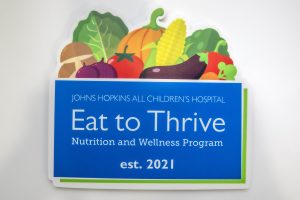A handful of St. Petersburg, Florida, families are doing their grocery shopping a little differently. Instead of meandering the aisles of a local supermarket, they’re working with specialty physicians, registered dietitians, health educators, and even a chef to harness the power of healthy foods as part of Johns Hopkins All Children’s Hospital’s new Eat to Thrive program.

The program, which launched in early November, aims to create better health outcomes for pediatric patients with chronic diseases by providing access to diagnosis-specific foods, nutrition education, and culinary training for the entire family.
“When families are told their child has special nutritional needs, a lot of families are still struggling with the fact that they’ve been given a diagnosis. For families who may already suffer from food insecurity, it’s going to be heightened when you add a diagnosis on top of it that requires a special diet plan,” explains Melanie Newkirk, director for Nutritional Services at All Children’s. “We know that getting the right food improves health outcomes. This program is designed to be an intervention, not just a one-time opportunity for a family to get food in a crisis situation.”
Early donors — including the Kolschowsky Foundation, which gave the first funding to help launch the Eat to Thrive program — can already see how their gifts will make an impact in the lives of high-risk families. Philanthropy has fueled the program from the beginning, starting with the reconfiguration of an existing space into a market with fresh produce, lean meats, grains, shelf-stable items, and even salt-free seasonings. Patients shop with insulated bags and work with a team member to develop a meal plan. Eat to Thrive provides supplies for five meals per week for the entire family, plus healthy snacks, for three months.
“One of our biggest goals is to have everyone in the family eat the meals and teach them how to make it tasty,” Newkirk says. “If a patient is being told they can’t eat what the rest of their family eats, you can imagine the negative impact that can have on one’s perception of their disease and how they’re able to manage it.”
The inaugural Eat to Thrive participants are patients with chronic kidney disease (CKD) on hemodialysis, which requires three visits per week to the hospital and a number of medications. Studies have shown that the nutritional plan of CKD patients can greatly impact their health-related quality of life, Newkirk says. But families often have difficulty managing the diet due to a lack of resources and experience, like cooking without salt or with fresh fruits and vegetables.

“CKD patients are very limited in what they’re able to eat, so we have culinary experts and our registered dieticians who work through it with them to show that they can still eat delicious foods that fit in with their diagnosis,” says Kellie Gilmore, All Children’s Community Health and Wellness manager.
While many hospitals have food pharmacy programs, Eat to Thrive is unique in that it serves a pediatric population, which Gilmore says donors are eager to support.
“What we’re learning is people really care about feeding children and getting them the right food,” she says. “When you ask someone if they want to support food for a family that is going to impact their health, it’s an easy ‘yes’ because we all want to see kids be healthier. And if this means less medicine, less time in the hospital, it’s a win-win.”
The team behind Eat to Thrive hopes to expand the program to other patient populations within All Children’s. But the biggest expense will be food, Gilmore says, especially with the program’s goal of feeding families long-term as the cost of food continues to rise.
“A small donation can make a huge difference. Even $100 can buy fresh produce for several families,” she says. “Almost any amount can make an impact with this program.”
Topics: Friends of Johns Hopkins Medicine, Johns Hopkins Medicine, Promote and Protect Health, Strengthening Partnerships